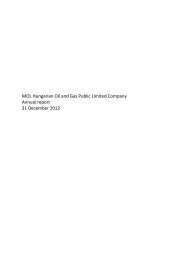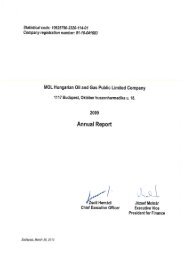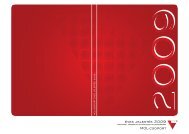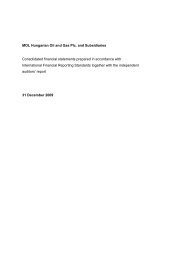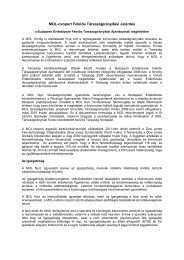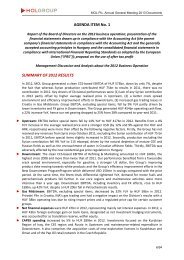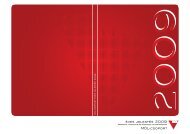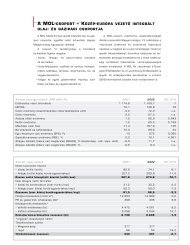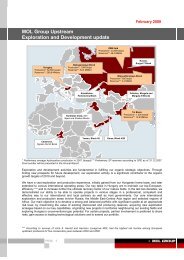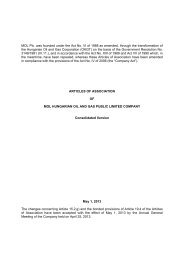MOL GROUP Annual Report
MOL GROUP Annual Report
MOL GROUP Annual Report
- No tags were found...
Create successful ePaper yourself
Turn your PDF publications into a flip-book with our unique Google optimized e-Paper software.
amounts and the timing of these future expenditures are reviewed annually, together with expectations on the rates used todiscount these cash flows. Long-term real discount rates are expected to be 4.8% (2009: 4.9%). Consequently, the carryingamount of these obligations (in case of environmental liabilities HUF 70,027 million and HUF 69,563 million, in case of fieldabandonment provision HUF 184,792 million and HUF 188,348 million as of 31 December 2010 and 2009, respectively, seeNote 20) is exposed to uncertainty.Impairment of non-current assets, including goodwillThe impairment calculation requires an estimate of the recoverable amount of the cash generating units, that is, the higherof fair value less costs to sell and value in use. Value in use is usually determined on the basis of discounted estimated futurenet cash flows. The most significant variables in determining cash flows are discount rates, terminal values, the period forwhich cash flow projections are made, as well as the assumptions and estimates used to determine the cash inflows andoutflows, including commodity prices, operating expenses, future production profiles and the global and regional supplydemandequilibrium for crude oil, natural gas and refined products. While such cash flows for each non-current asset orinvestment reflects the management’s best estimate for the future, these estimates are exposed to an increased uncertaintyas a result of the general economic recession experienced worldwide and also in the Central-Eastern European region wherethe Group operates. Discount rates were derived from the USD-based weighted average cost of capital for the Group (2010:8.4%, 2009: 8.0%) Increase in the rate reflects the increased risk factors due to the worldwide recession. In each case theserates are adjusted for segment-, country- and project-specific risks, as applicable. Impairment recorded in the consolidatedincome statement amounts to HUF 17,548 million and HUF 13,066 million in 2010 and 2009, respectively. These chargesinclude an impairment loss HUF 15,074 million on other intangible assets (2009: HUF 1,612 million and also impairmentloss of HUF 4,656 million on goodwill) an impairment loss of HUF 10,017 million (2009: HUF 9,059 million) and a reversal ofimpairment of HUF 7,543 million (2009: HUF 2,261 million) on property, plant and equipment. Carrying amount of goodwillis HUF 71,031 million and HUF 70,126 million as of 31 December 2010 and 2009, respectively (see Note 4).Availability of taxable income against which deferred tax assets can be recognizedDeferred tax assets are recognized for all unused tax losses to the extent that it is probable that taxable profit will be availableagainst which the losses can be utilised. Significant management judgment is required to determine the amount of deferredtax assets that can be recognized, based upon the likely timing and level of future taxable profits together with future taxplanning strategies. The carrying value of such recognized deferred tax assets was HUF 10,290 million and HUF 28,064million as of 31 December 2010 an 2009, respectively (see Note 30).Actuarial estimates applied for calculation of retirement benefit obligationsThe cost of defined benefit plans is determined using actuarial valuations. The actuarial valuation involves makingassumptions about discount rates, future salary increases and mortality or fluctuation rates. Due to the long term nature ofthese plans, such estimates are subject to significant uncertainty. Provision for retirement benefit is HUF 15,144 million andHUF 14,416 million at 31 December 2010 and 2009, respectively (see Note 20).Outcome of certain litigations<strong>MOL</strong> Group entities are parties to a number of litigations, proceedings and civil actions arising in the ordinary course ofbusiness. Management uses estimations when the most likely outcome of these actions is assessed and provision isrecognized on a consistent basis. Provision for legal claims is HUF 20,067 million and HUF 18,161 million at 31 December2010 and 2009, respectively (see Note 20 and 35).2.5 Issued but not yet effective International Financial <strong>Report</strong>ing StandardsAt the date of authorisation of these financial statements, the following standards and interpretations were in issue but notyet effective:IAS 24 - Related Party DisclosureThe amendments to IAS 24 Related Party Disclosures become effective for financial years beginning on or after 1 January2011 and must be applied retrospectively. The revised standard simplifies the disclosure requirements for entities that arecontrolled, jointly controlled or significantly influenced by a government and clarifies the definition of a related party. As aresult, such a reporting entity is exempt from the general disclosure requirements in relation to transactions and balanceswith the government and government-related entities. The amendment has no impact on the disclosures of the Group.IAS 32 Financial Instruments: PresentationThe amendment to IAS 32 is effective for annual periods beginning on or after 1 February 2010 and requires that rights,options and warrants to acquire a fixed number of an entity’s own equity instruments for a fixed price of any currency areequity instruments if certain criteria are met. The amendment will have no impact on the financial position of the Group.IFRIC 14 – IAS 19-The limit on a Defined Benefit Asset, Minimum Funding Requirements and their InteractionThe amendment to IFRIC 14 Prepayments of a minimum funding requirement was issued to remove the unintended consequencein IFRIC 14 that in some cases entities are not permitted to recognize as an asset some voluntary prepayments for minimumfunding contributions. The amendment becomes effective 1 January 2011 and has no material impact on the Group.IFRIC 19 Extinguishing Financial Liabilities with Equity InstrumentsThis interpretation addresses the accounting by an entity that issues equity instruments to settle financial liability. The equityinstrument is measured at fair value and the financial liability is derecognized, fully or partly, based on the “considerationpaid”. The interpretation is effective for annual periods beginning on or after 1 July 2010 and will have no material impacton the Group.Improvements to IFRSsIn May 2010 the Board issued its first collection of amendments to its standards, primarily to remove inconsistencies andclarify wording. These amendments will be effective from 1 January 2011 unless otherwise stated. The Group has not yetadopted the following amendments but it is anticipated that these changes will have no material effect on the Group’sfinancial statements.IFRS 1 First-time Adoption of International Financial <strong>Report</strong>ing StandardsThe annual improvements to IFRS 1 include: a) accounting policy changes in the year of IFRS adoption - if a first-timeadopter changes its accounting policies or the use of exemptions in IFRS 1 after it has published its interim financial reportin accordance with IAS 34 but before its first IFRS financial statements, it should explain those changes; b) revaluation basisas deemed cost – clarifies that a first-time adopter is permitted to use event-driven fair value as deemed cost during thefirst IFRS period and c) use of deemed cost for operations subject to rate regulation for certain items of property, plant andequipment or intangibles.IFRS 3 Business CombinationsAmendment to IFRS 3 specifies that the option to measure non-controlling interests either at fair value or at proportionateshare of the acquiree’s net identifiable assets applies only to non-controlling interests that are present ownership interests.All other components of non-controlling interests should be measured at their acquisition date fair value, unless anothermeasurement basis is required by IFRSs.IFRS 3 specifies that requirements to measure awards of the acquirer that replace acquiree share-based payment transactionswith regards to IFRS 2 applies also to such transactions of the acquiree that are not replaced. The amendment also clarifiesthat market-based measurement of replacement awards applies to all replacement awards regardless of whether the acquireris obliged to replace the awards or does so voluntarily.Notes to the financialstatementsIFRS 9 Financial Instruments – Classification and measurementThe IFRS 9 was issued on 12 November 2009 and is intended to replace IAS 39 Financial Instruments: Recognition andmeasurement. The standard introduces new requirements for classifying and measuring financial assets that must be appliedstarting 1 January 2013. According to IFRS 9 all financial assets are initially recognised at fair value plus transaction costs. Thestandard also eliminates the available-for-sale and held-to-maturity categories currently existing in IAS 39. Classification ofcurrently existing financial instruments of the Group will change accordingly.The last amendment to IFRS 3 clarifies that IAS 32, IAS 39 and IFRS 7 do not apply to contingent consideration from a businesscombination which occurred before the effective date of the revised standard IFRS 3 in 2008.All amendments to IFRS 3 are effective for annual period beginning on or after 1 July 2010.IFRS 7 Financial Instruments: DisclosuresThe improvement to IFRS 7 clarifies disclosure requirements regarding credit risk and collateral held in order to enable usersbetter to understand the nature and extent of risks arising from financial instruments.108 <strong>MOL</strong> Group annual report 2010 109



